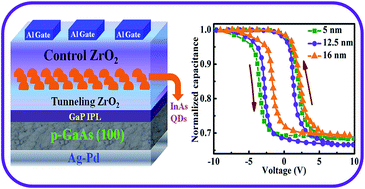Size effect of InAs quantum dots grown by metal organic chemical vapor deposition technique in storing electrical charges for memory applications
Abstract
Catalyst-free growth of InAs quantum dots (QDs) with different sizes and densities was undertaken by metal organic chemical vapor deposition technique to investigate their capability and the effect of size on charge storage. The QDs were grown on a high-k dielectric, ZrO2, layer, which was deposited onto the GaAs substrate passivated with an ultra-thin GaP layer. The size and density of the QDs were controlled by varying the growth temperature. To demonstrate the effect of QD dot size on charge storage behavior, they were used as charge storing nodes in a GaAs metal-oxide–semiconductor based memory device. From capacitance–voltage measurements, it was observed that the hysteresis width of the device and the density of stored charge increase with a decrease in size of the QDs. This is due to size quantization, for which the surface potential as well as the generation of strongly localized trap levels become significant. On the other hand, the charge retention is found to increase on increasing the dot size due to enhanced conduction band offset between the QDs and the substrate, in which tunneling back the stored carriers is minimized.


 Please wait while we load your content...
Please wait while we load your content...